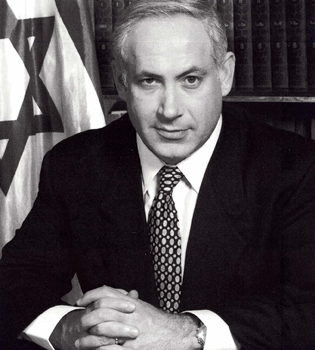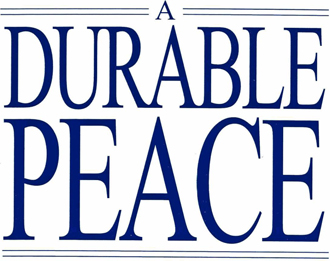A Durable Peace (70 page)
Authors: Benjamin Netanyahu

6.
The New York Times,
Mar. 18, 1991.
7.
Telephone discussion with Eliyahu Rosenthal, Israel Water Authority.
8.
Ibid.
9.
Saudi News Agency, Jan. 2, 1989.
10.
The Jerusalem Post,
May 19, 1992.
11.
Addendum to the report of the Commissioner-General of the United Nations Relief and Works Agency for Palestine Refugees
in the Near East, “Financial Situation of UNRWA in 1990 and 1991 and Budget Estimates for 1992–93.”
1.
Cicero quoted in Stern,
Greek and Latin Authors,
vol. 1,
p. 19
.
2.
Jabotinsky quoted in Benzion Netanyahu,
Jabotinsky’s Place in the History of the Jewish People
(Haifa: University of Haifa Faculty of the Humanities Publications, 1981),
p. 15
.
3.
Shoah, An Oral History of the Holocaust: The Complete Text of the Film by Claude Lanzmann
(New York: Pantheon, 1985),
p. 200
.
4.
Protocols of the Wannsee Conference, Jan. 20, 1942, in Yitzhak Arad, ed.,
Documents of the Holocaust
(Jerusalem: Yad Vashem, 1981),
p. 254
.
5.
In fact, many newspapers ridiculed the address. Carl Sandburg,
Abraham Lincoln
(New York: Harcourt, Brace, 1954),
pp. 445
–
46
.
6.
Jabotinsky,
in Do’ar Hayom,
May 17, 1929. Cited in B. Netanyahu,
Jabotinsky’s Place,
p. 7
.
7.
Ha’aretz,
Aug. 27, 1992.
9.
Mark Twain,
The Complete Essays of Mark Twain,
Charles Neider, ed. (Garden City, N.Y: Doubleday, 1963),
p. 249
.

A Durable Peace
My friend Merv Adelson deserves all thanks for introducing me to Larry Kirshbaum of Warner Books, who persistently and doggedly
pursued me to take time out from my schedule to complete the task of preparing this book for publication. Larry was not only
successful in hunting his quarry (me), but also unusually generous with perceptive and invaluable editorial advice. At his
suggestion, we touched as little of the original historical material as possible but updated the book to reflect the events
of the last few years. Larry also brought with him excellent technical assistance in the person of his son Michael, who expertly
manned the computer, kept up with my dictation, and proved that we are truly living in an electronic age. To both members
of the Kirshbaum family, I extend my warmest thanks, as I do to David Bar Ilan, who applied his critical intelligence to the
manuscript, old and new. As always, my wife, Sarah, put up with our impossible hours to complete the book with great understanding
and even greater support.

A Place Among the Nations
The task of writing this book would have been daunting enough in itself, but writing it in the midst of the turbulence of
Israeli politics made it all the more so. A number of people helped me overcome what otherwise would have been insurmountable
difficulties.
Dr. Dore Gold of the Jaffee Center for Strategic Studies at Tel Aviv University and Douglas Feith read the manuscript and
suggested important revisions. My brother, Dr. Iddo Netanyahu, and my cousin, Nathan Mileikowsky, went over every word, steering
me away from obscurity and toward what I hope is greater clarity and focus. The unwavering enthusiasm of Linda Grey and Ann
Harris of Bantam Books was a constant source of encouragement, as were Ann’s good-natured yet incisive editorial comments.
Rami Elhanan and Jackie Levy calmly produced the maps and illustrations in the face of ever-changing demands. Esther Loewy,
Avishai Cohen, and Ita Hanya verified facts and quotations, relentlessly weeding out inaccuracies and hunting down reliable
information. Ralph Cwernan methodically tracked down material from some of my UN speeches, which I incorporated into the text.
Above all, Yoram Hazony acted as an amalgam of researcher, editor, and typist, bringing a perceptive intelligence, as well
as much patience and dedication, to work that often continued literally around the clock. To each of them I am deeply indebted,
and to each I offer my thanks.
Last and most important, I owe an inestimable debt to my wife, Sarah, who gave me her clear insights into what was important
and what was not, combining wise judgment with a profound sensitivity, while offering me her firm convictions and her courage.
B
ENJAMIN
N
ETANYAHU

A DURABLE PEACE
“Powerful, lucidly argued… impressive…. Very few Israeli spokesmen have ever understood the Arab arguments against Israel so
well, or deployed counterarguments so skillfully…. Often entertaining as well as instructive.”
—C
ONOR
C
RUISE
O’B
RIEN
,
N
EW
Y
ORK
T
IMES
B
OOK
R
EVIEW
’Brilliant… mastery… shows that Netanyahu is as tough, as sharp, and as eloquent as his political enemies fear. And then some.” —
N
ATIONAL
R
EVIEW
“A good introduction to the man and his views… artful.” —
J
ERUSALEM
P
OST
“Scholarly yet swift…. Seasoned watchers of Middle Eastern affairs and interested laymen alike will enjoy Mr. Netanyahu’s clarity
and thoughtfulness… a profound effort to explain the issues thoroughly while not being didactic… a pleasure to read.” —
W
ASHINGTON
T
IMES
Israel at the half-century mark is one of the great success stories of our time. Now, as the Jewish State enters the twenty-first
century, comes a new, thoroughly revised edition of Benjamin Netanyahu’s acclaimed
A Place Among the Nations,
updated to reflect both recent developments and Netanyahu’s unique vantage point.

We live in a time of intense geopolitical change. Communism, fascism, and other “isms” are crumbling into dust. But Zionism,
the national liberation movement of the Jewish people, has triumphantly endured. What is the secret of that endurance—and
what is the prognosis for its continued success?
From the rise of Zionism to the latest peace initiatives, Benjamin Netanyahu traces the origins, history, and politics of
Israel’s relationship with the Arab world and the West. He exposes some of the most common—and often shocking—misrepresentations
and myths about Arab-Israeli issues, replacing them with facts. And he explores the themes that have shaped his vision of
Israel and its position in the world:
- What is the foundation of the Jewish claim to the land of Israel?
- What is the real source of conflict between Arabs and Israelis?
- How has the West both contributed to and jeopardized Israel’s security throughout the decades?
- How have Arab groups used warfare to achieve what might have been otherwise unattainable ends?
- Why is the status of the West Bank, as well as Gaza and the Golan Heights, so crucial to Israel?
- Why is any hope for peace in the Middle East linked to a clear recognition of Israel’s right to exist?
- Even with the collapse of the Soviet Union, why is a strong Israel essential to the stability of the world?
Netanyahu writes as an Israeli who wishes to see a secure Israel at peace with its neighbors. But for this to happen the battle
for truth must be won. Closely reasoned, meticulously documented, and often shattering in its revelations, A DURABLE PEACE
sheds welcome light on the Middle East debate. It is a most fitting tribute to Israel today.
*
The name Palestine is derived from the Philistines, a seafaring people that invaded the coast of the land
of Canaan from the sea around 1200
B.C.E.,
shortly after the Jewish conquest overland from the east. The main Philistine dominions never extended much farther than the
coastal strip between Gaza and today’s Tel Aviv, and the Philistines disappeared as a people under the heel of the Babylonians.
It was the Roman Empire, bent on destroying every vestige of Jewish attachment to the land, that invented the name Palestine
to replace Judea, the historic name of the country.
Thus according to Professor Bernard Lewis:
The official adoption of the name Palestine in Roman usage to designate the territories of the former Jewish principality
of Judea seems to date from after the suppression of the great Jewish revolt of Bar Kochba in the year 135
C.E.
…. it would seem that the name Judea was abolished… and the country renamed Palestine or Syria Palestine, with the… intention
of obliterating its historic Jewish identity.
3
While this Roman name disappeared in the land itself shortly after the conquest by the Moslems,
4
Christian cartographers
kept the name alive in their own lands and eventually bequeathed it to the Allied negotiators at Versailles and the inhabitants
of the land, who adopted it only after the British took control. According to Professor Lewis:
By the early twentieth century, with the predominance of European influence… the name Palestine came to be used even in
the country [i.e., in Palestine]. This use was, however, in the main confined to Christians and to a very small group of westernized
Muslims. The name was not used officially, and had no precise territorial definition until it was adopted by the British to
designate the area which they acquired by conquest at the end of World War I.
5
Thus, up until the twentieth century, the name Palestine referred exclusively to the ancient land of the Jews—as did the
names Judea, Judah, Zion, and Israel. It had never yet been argued that there existed a “Palestinian people” other than the
Jews. The Arabs who lived there were called Arabs, just as the Armenians, Turks, Druze, and Circassians who migrated into
Palestine were then still called Armenians, Turks, Druze, and Circassians. With the exception of the Jews, who called the
land Eretz Yisrael (the Land of Israel) and viewed it as their national home, all of these groups considered themselves as
living in the realm of Southern Syria.
